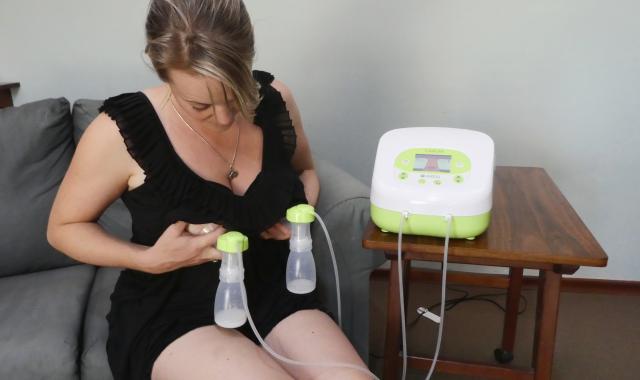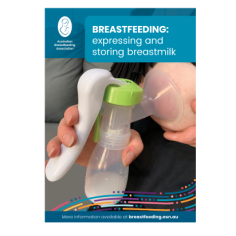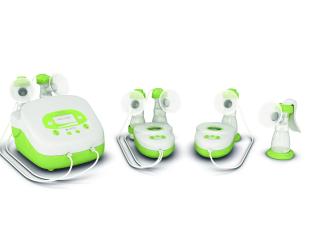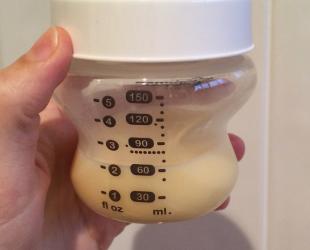If you decide to pump full time for your baby, here's how to make it work.

If you are finding it very difficult to breastfeed your baby (or you aren’t able to) you may choose to exclusively express and provide breastmilk to your baby in a bottle or cup. This may be a short-term or long-term situation.
Some reasons you may choose to exclusively express
-
Your baby may be unable to feed well from the breast due to a physical or medical condition (eg a cleft, heart problem, low tone or tongue-tie).
-
You may have unresolved breast or nipple challenges.
-
You may be separated from your baby.
-
You may find feeding from the breast emotionally challenging.
-
You may be embarrassed with feeding in public.
-
You think it might be easier.
Your breastmilk is important for your baby so well done for being determined to exclusively express. Whether you pump or hand express, it’s extra work, so getting some help and support is important. You may even find that getting some skilled help enables you to work through your feeding challenges and breastfeed your baby directly.
Common questions about exclusive expressing.
- If you are exclusively expressing, you’re going to find it easier with quality, hospital grade, double electric pump designed for long-term use. You can hire a hospital-grade electric pump from ABA or you may decide to buy your own.
- Some mums also buy a smaller personal electric pump to use when they're out but use the hospital grade pump when at home.
This may depend on the age of your baby and how much breastfeeding they've been doing up till now.
In the first few days, a newborn baby takes in very small amounts of colostrum each feed (see below). Then when your milk ‘comes in’ after a few days, the volume of milk you make, and what your baby takes increases.
|
Time (hours) |
Intake (mL/feed) |
|
First 24 |
2-10 |
|
24-48 |
5-15 |
|
48-72 |
15-30 |
|
72-96 |
30-60 |
Average intakes of colostrum by healthy, term breastfed babies
- If you are still in the early days, you will need to express at least 8 times each 24 hours to mimic how often a baby breastfeeds.
- Research has shown that an exclusively breastfed baby between the age of 1 to 6 months drinks an average of 750–800 mL in a 24-hour period (though some babies may only need about 500 mL and others will need 1000mL or more). So if you’re expressing to meet all your baby's needs, you will need to aim for this.
- The amount of milk babies take from feed to feed can vary and the length of time at the breast doesn't always reflect the amount of milk taken. You may find it helpful to make up smaller bottles (eg about 60mL) and top them up with further small amounts as needed.
- Once your baby is having solid food, their breastmilk needs may reduce, so you may not need to express as much. However, it’s important to remember that breastmilk remains the most important source of nutrition for your baby’s first 12 months.
- The amount of time it takes to express may vary, depending on the time of the day, the pump you're using (and the setting on the pump), your expressing technique and your milk flow rate.
- 15 minutes is a common length of time, but you may need a little more or a little less.
- Once your milk stops flowing, you can continue to express for a few more minutes, as this often triggers another let-down.
- Pumping for longer than 30 minutes is usually too long and not necessary.
When you are exclusively expressing, you will be very aware of how much milk you are making, and you will notice even small changes in your supply. Here are some tips if you need to get more milk.
- Add in a few extra expressing sessions over the course of a 24-hour period. Expressing more often is more effective at increasing supply than longer expressing sessions.
- Increase the skin-to-skin time spent with your baby.
- If you continue to pump for a few minutes after your milk flow stops you might get another let-down.
- Try some short pumping sessions close together, to mimic a baby cluster feeding. Pump for 5 to 10 mins at a time but repeat this several times over the course of an hour or two.
- Making use of a pumping bra means you can express hands free, allowing you to do other things while pumping.
- Use breast compressions to get more milk.
- Finish off each session with a few minutes of hand expressing. This will help to empty your breasts further and increase your milk supply.
- Using a technique called ‘hands-on pumping’ can help a mum to produce more milk over several expressing sessions.
If you try the above suggestions and still can’t increase your supply enough, there are substances (called galactagogues) that in some cases may help you to boost your milk supply. You may like to discuss the use of galactagogues with your doctor. These substances don’t take the place of extra expressing, you will still need to pump often.
Feeding expressed breastmilk
If all your baby’s feeds will be with your expressed breastmilk, then bottles will probably be most convenient. If you have experienced feeding your baby at the breast and would like to try and make bottle-feeding as similar to breastfeeding as you can, you could:
-
Feed your baby according to their need rather than to a schedule. You can do this by watching for their feeding cues.
-
Bottle-feed your baby in a way that gives them more control of how much they drink. This is called paced bottle-feeding.
-
Alternate the side your baby is held when being bottle-fed. This can help both sides of baby's vision and neck muscles to develop equally.
If you are providing your baby with expressed breastmilk temporarily and plan to establish breastfeeding, your baby may be receiving your EBM via a feeding tube or supply line. You may also choose to cup feed your baby.
What about bonding with my baby?
You may be worried that you won’t be able to bond as well with your baby, compared to if they are breastfed. Breastfeeding can help bonding but there are many ways to form a connection with your baby. If you are the primary caregiver, you’ll still be spending lots of time with your baby.
You might like to try some of the following:
-
Have lots of skin-to-skin contact while feeding or at any time. Skin-to-skin benefits your baby but it also increases oxytocin which helps with your milk supply.
-
Hold or have your baby near you as you express. You could use a hands-free expressing bra to help with this.
-
When you feed your baby, hold them in a breastfeeding position, make eye-contact and talk or sing to them.
-
Wear your baby in a sling around the house or when you are out.
-
Sleep close to your baby.
-
Be encouraged that providing your breastmilk for your baby is a bonding gift in itself.
If you are exclusively pumping because you have returned to full-time work or because your baby is in the NICU, you're doing so well! Expressing and providing your breastmilk means that you are maintaining a special bond with your baby even though you can't physically be there at all times.
The need for support
Mums who are exclusively expressing are very dedicated and deserve and need respect and support. ABA is there for you no matter how you feed your baby.
© Australian Breastfeeding Association May 2022
Read more about expressing and storing
Evidence-led info and practical tips from our Breastfeeding Information Series
Breastfeeding: expressing and storing breastmilk




